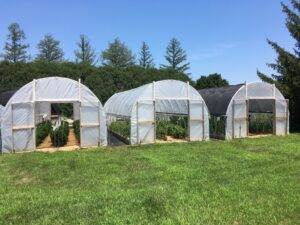On hot days in the summer, high tunnel growers may wonder whether to place shadecloth on high tunnels. Considering excessive heat inside the structures that may lead to plant stress, blossom drop and unmarketable fruit, there is a rational for doing it. However, it is important to realize the limitations of placing shadecloth on high tunnels in the Midwest.
A few years ago, we compared the effect of 30% black shadecloth on temperature and light levels inside a high tunnel. We found shadecloth significantly decreased maximal temperatures for about 10 degrees Fahrenheit while it had no effect on nighttime temperatures. In terms of light reduction, it ranged from 60% in a sunny day to 30% in a cloudy day. More information about this comparison can be found in the article Temperature and Light Intensity in a High Tunnel Covered with 30% Black Shadecloth in Issue 619. In our experience of growing determinate tomatoes in the high tunnel with 30% shadecloth, we noticed there was less yellow shoulder fruit. However, we had to deal with plants with extended shoot length, which means the plants need to be tied more frequently to prevent them from falling down.
A study recently published by Dr. Ajay Nair and his group at Iowa State University closely studied the effects of placing shadecloth on high tunnels for growing colored bell pepper in the Midwest. This study compared bell pepper yield, quality, and plant growth when they were grown in high tunnels with no shadecloth, 30% light-reducing shadecloth, and 50% light-reducing shadecloth (shadecloth was installed in June and remained on the high tunnel throughout the entire season). The study found the harvest of colored bell pepper was delayed for about a week in the high tunnels placed with shadecloth. This is likely attributed to reduced average air temperatures under the shadecloth. On the positive side, shadecloth reduced the incidence of sunscald on colored bell pepper. The highest yield was observed in the high tunnel without shade cloth although this was not significantly different from 30% shadecloth; The lowest yield was observed in the high tunnel with 50% shadecloth. The shade treatments did not affect sugar content of colored bell pepper. Detailed information about this research can be found in the article Cultivar Selection and Placement of Shadecloth on Midwest High Tunnels Affects Colored Bell Pepper Yield, Fruit Quality, and Plant Growth.

Figure 1. Compare colored bell pepper production in high tunnels with and without shadecloth. Photo by Ajay Nair.
The take home message, the use of black shadecloth above 30% light reduction is not appropriate in Midwest high tunnel production systems. Using 30% shadecloth may increase marketable fruit but did not increase total fruit yield. Harvest of colored bell pepper in high tunnels may be delayed by using shadecloth.